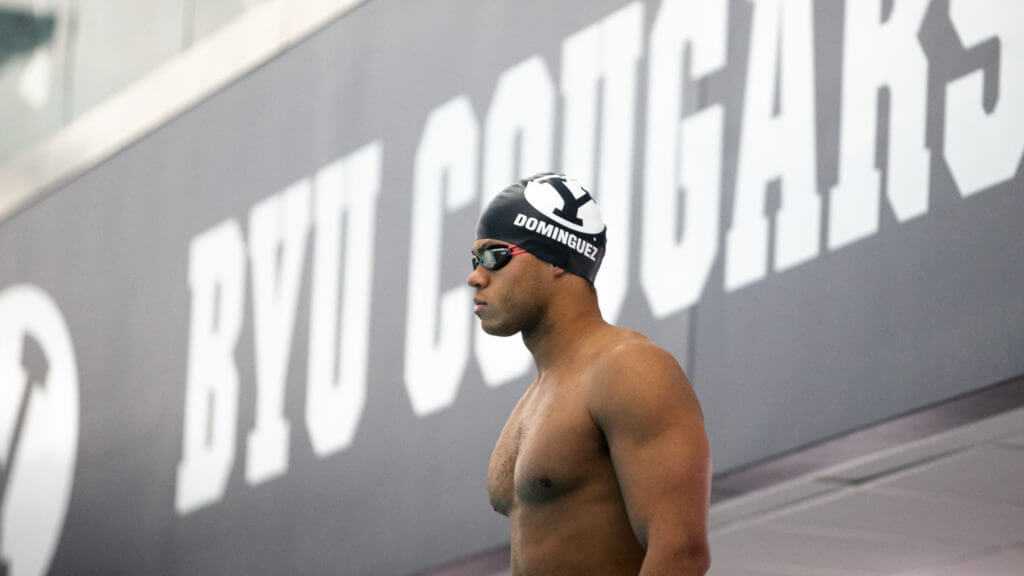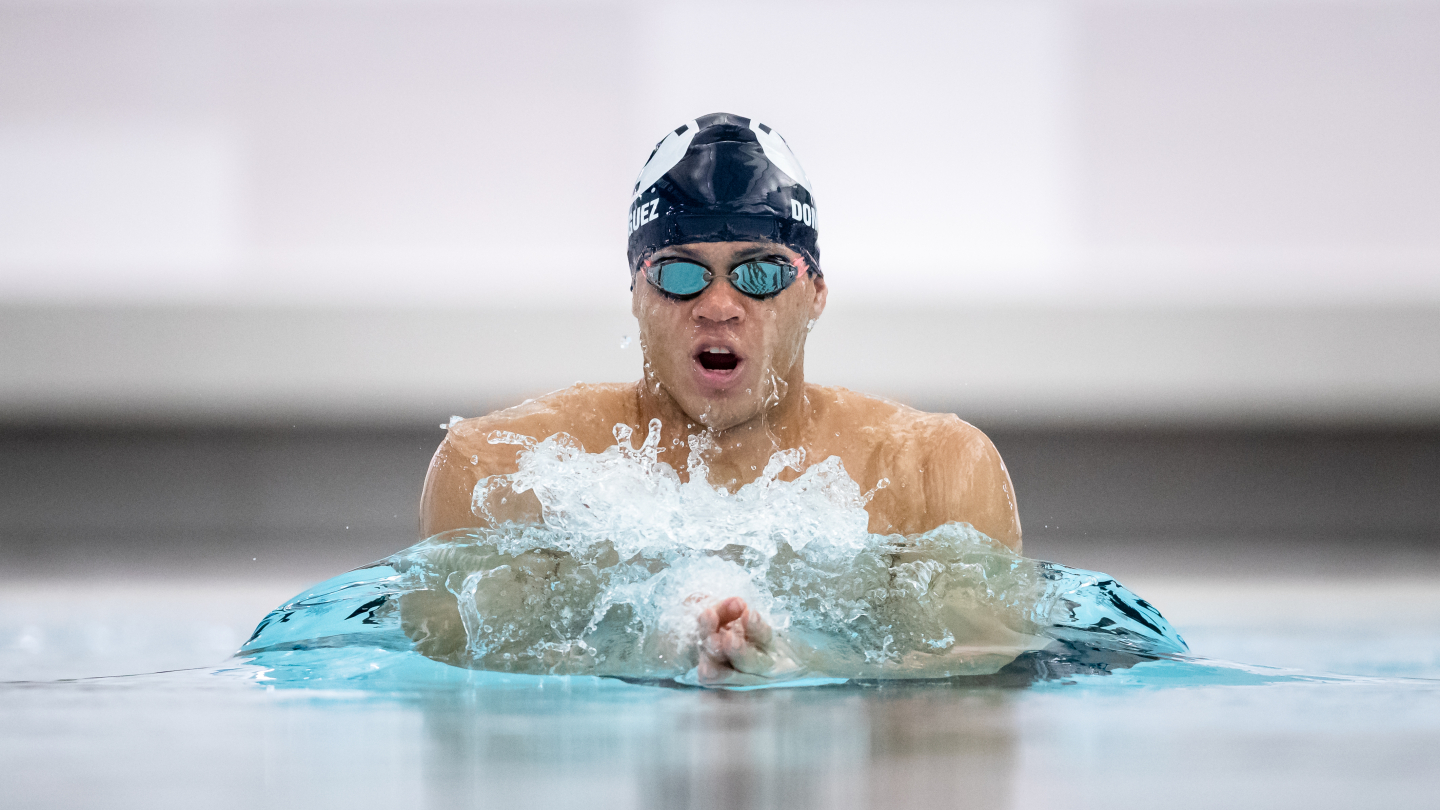After ACL Tear, Dominican Republic’s Josue Dominguez on a Mission in Tokyo

Editorial content for the 2021 Tokyo Olympic Games coverage is sponsored by GMX7.
See full event coverage. Follow GMX7 on Instagram at @GMX7training #gmx7

After ACL Tear, Dominican Republic’s Josue Dominguez on a Mission in Tokyo
Josue Dominguez’s choice of which dream to pursue wasn’t much of a choice when he sat down to think about it in 2015.
Dominguez had gravitated toward the pool from a young age in the Dominican Republic. He was electrified by watching Jacinto Ayala qualify for the Olympics in 2008, representing a country with little substantive history in the sport.
But even from a young age, Dominguez’s path was set by his family. He was raised in the Church of Latter Day Saints. Both parents, Jorge and Jacqueline, served missions in their youth and returned with fond stories. Dominguez knew, even before the twin threads of his life converged with the chance to represent BYU in the pool, that he would pursue a similar mission.
In 2015, those paths meandered into conflict with each other. Dominguez had swum an Olympic B cut in 2014, good enough to get him to the 2016 Rio Olympics. The swim came just after his 18th birthday, when his interest in college in the U.S. and BYU in particular intensified.
When Dominguez arrived in Provo, he faced a challenge that’s pronounced for athletes, of how to schedule their required two-year mission around their athletic requirements and aspirations. Serving his mission at the start of his career would write off the Rio Games. Waiting would let him fulfill his Olympic dream, but it might imperil the next Olympics and limit the breaststroker’s ability to reach his full potential.
After leaning on support at the university and his family, the choice was clear.
“When I was a kid growing up in the church, I always wanted to go and serve a mission,” Dominguez said recently. “Both of my parents served missions, and sometimes when we were doing chores or at home at night when we gathered together, they would tell stories about their mission. My feelings were just, amazed about all the nice experiences they had, and since I was a kid, I wanted to have my own experiences as a missionary and help other people.”
Already winding, Dominguez’s journey took an unplanned detour when he tore his ACL during the mission in Puebla, Mexico. It took more than two years to get back to his best, after he finished the last year of his mission with a surgically repaired knee.
But now, nearly seven years after he first attained a B cut for the Games, Dominguez is ready to have his Olympic moment.
“When I got old enough to understand everything, I was like, that’s what it means to the country when someone qualifies for the Olympics,” he said. “I wanted that. I wanted to qualify for the Olympics. I wanted to be part of the national team. And I’ve been working hard this, to be in the Olympics, I can say, for more than 10 years.”
A Dominican Prodigy
In a country not known for its aquatic prowess, Josue Dominguez was a bona fide prodigy. He made the Dominican national team by age 12. The Santiago native was the country’s foremost breaststroker by 17, qualifying for the Youth Olympics in 2014 and setting a national record.
His entry into world swimming landed him on the radar of BYU and made a college dream in the United States a reality. But it also brought a choice of how to craft his future.
Ultimately, he chose the mission in 2015, knowing what it would mean for his career. Missionaries are supposed to devote their time to the project they’re assigned at a branch of the church, usually in the developing world. That means limited physical activity, no access to training facilities beyond the most rudimentary and certainly no time for the kind of rigorous workouts in the pool Dominguez had gotten used to at his club, Academia Deportiva Acuatica. He wouldn’t be regularly back in the water again, if all went as planned, until the spring of 2017.
Dominguez could feel his swim physique winding down as the neared his departure in the spring of 2015. He pushed as hard as he could until the final meets that spring, but felt some dislocation as his training waned. He was preparing his body, he said, to get used to not having daily workouts to orient around. Though BYU’s coaches provided resources to maintain some baseline fitness, and Dominguez dabbled with workouts like P90x, it was no substitute for a singular focus on swimming since he was a child.
One of the ways he kept in shape and kept his competitive juices flowing in Mexico was basketball. It worked great until December, when he landed awkwardly on his leg and tore his ACL. He returned to the United States for several months in early 2016 to have surgery and do the initial rehab, before returning in the spring of 2016 to resume the final year of his mission.
Back to his Best
When Josue Dominguez finally got back in the water in 2017, the path wasn’t a straight line. He’d had to wait not just the two years of his mission but longer afterward, to make sure his knee was structurally sound given all the rehab he’d missed while away.

Josue Dominguez; Photo Courtesy: Courtesy of BYU Athletics
There were moments when he felt close to normal, only to be slapped back to reality by a time slower than he’d posted in years. He had to stomach the disappointment of races that ended in times he used to routinely throw down in practice.
At his first meet back, for instance, he was heartened by a 100 free that was in the ballpark. Then a 100 individual medley time brought him back down. His endurance was the last thing to come back, the aerobic base collected over years as a teen having eroded. A 2:36 200 breast that was 20 seconds shy of his best was a particularly painful blow to absorb.
“I was like man, this is really hurting,” he said. “It was rough. I was doing all that I could, but I couldn’t see the fast times that I thought I would see. It really took time. It took a lot of patience, a lot of hard work, being really dedicated to it.”
While Dominguez’s injury was a special case, the staff at BYU had experience shepherding athletes through a part of his challenge. That rust after a mission is an occupational hazard for coaches at BYU, so the message of patience and the relieving of expectations was an easy sell.
By 2018, Dominguez was back closer to where he wanted to be. In the 100 breast, he was back in the 1:02s by 2018, then at 1:01 the following year. In 2021, he set his best time at 1:00.68. It took until 2019 for him to get within .02 of his national record in the 200 breast. He’s since trounced that by nearly three seconds, entering Tokyo with a time of 2:15.14. He’ll swim both events at the Games, and he also holds the Dominican record in the 50 breast.
The patience has paid off for BYU, as well. Dominguez swam both breaststroke events at the NCAA Championship this spring, his junior season. He was the Mountain Pacific Sports Federation co-swimmer of the year and the only MPSF men’s representative at NCAAs. He’s set a slew of records for BYU, which has won five straight league titles.
And all that patience and perseverance is now set to culminate with an Olympic spot.
“Now to make it, it’s something I can’t describe,” Dominguez said. “It’s a really big accomplishment for me and also for the country.”




